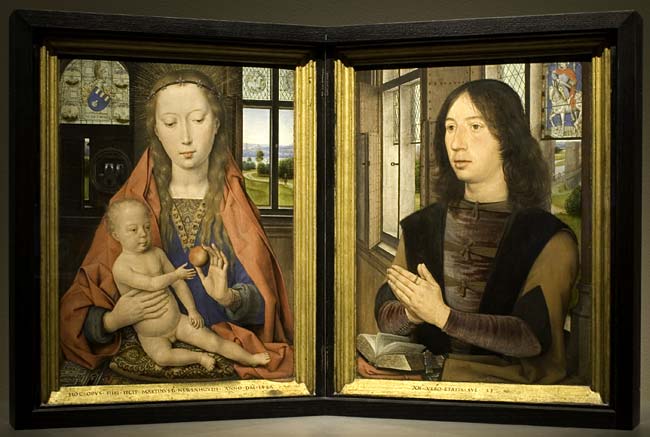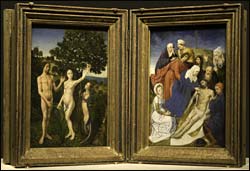In close cooperation with the National Gallery, which presented it last year under the title of Prayers and Portraits, Unfolding the Netherlandish Diptych, the Koninklijk Museum voor Schone Kunsten Antwerpen brought together thirty diptych jewels, a number of which have been reunited for the first time after many years. The fifteenth and sixteenth-century works shed light on a rich period in Flemish history of art. Antwerp is the only place where the exhibition can be visited.
New heights for the diptychs
Diptychs consist of two panels of the same shape and size. The panels are hinged so that they can be opened and closed. Diptych has a long history and were already used as writing tablets in antiquity They reached new heights again in the early Netherlands art of painting. Jan van Eyck, Rogier van der Weyden, Hugo van der Goes and Hans Memling painted masterpieces in this format. The dimensions of the diptychs range from the minuscule to the monumental; the subject is generally religious, but can also be secular - portraits of married couples, sometimes accompanied by their children. In the course of time, a great many of these fragile objects were destroyed. Some hung on walls, others were put away in a box (case), a purse or a chest. Smaller diptychs could be put on a table or lectern, like a book.
The Devotio Moderna.
The sudden success of the diptych in the Low Countries is connected with the Devotio Moderna This religious movement, which arose in the late 14th century, brought about cultural changes throughout Northern Europe. The passion of Christ and the devotion to Mary became the central themes in Christian literature. Because of their intimate nature, diptychs are suitable for a more individual religious experience. The form did not only find favour with monastic orders, but also with the well-to-do middle class that emerged in The Netherlands in the 15th century. In imitation of monarchs and the aristocracy, bankers and merchants wanted to be depicted praying next to the Madonna. Diptychs generally show the praying benefactor on the right and the Madonna on the left panel. The benefactor's gaze was not focused on Jesus, but on Mary, who here has the role of intermediary. She generally looks at her Child, who in His turn looks or points at the benefactor. The flourishing art market gave an extra impulse to the production
Absolute top works
The exhibition presents around thirty diptychs from The Low Countries from the 15th and 16th century. Absolute top works in this exhibition are the diptych with The Fall of Man by Hugo van der Goes (Vienna, Kunsthistorisches Museum), the Virgin and Child with two angels and Christ taking leave of his mother by Gerard David (Basel, Kunstmuseum), Virgin at Prayer and Christ as Saviour by Quinten Massijs (Madrid, Museo del Prado). Three outstanding diptychs by Rogier van der Weyden: the Virgin and Child (Madrid, Museo Thyssen-Bornemisza), the Saint George and the Dragon (Washington, National Gallery of Art); Virgin and Child (Doornik, Museum voor Schone Kunsten) and Jean de Gros (Chicago, Art Institute); Virgin and Child (San Marino, California, Huntington Art Gallery) and Philippe de Croÿ (Antwerp, Koninklijk Museum voor Schone Kunsten). as well as the small diptychs meticulous created by Hans Memling D. The stillness, beauty and refinement. they radiate can still deeply move the enthusiasts of today.
Illustration: Hugo van der Goes The Fall of Man Wien, Kunsthistorisches Museum +The LamentationWien, Kunsthistorisches Museum
PUBLICATIONS
J.O. Hand, C.A. Metzger, R. Spronk, Prayers and Portraits, Unfolding the Netherlandish diptych, National Gallery of Art, Washington & Yale University Press (339 p., € 65)
J. O. Hand, R. Spronk, Essays in Context: Unfolding the Netherlandish Diptych, Yale University Press (E), 256 p., € 36,50
To see more illustrations, click on VERSION FRANCAISE at the top of this page
| 








